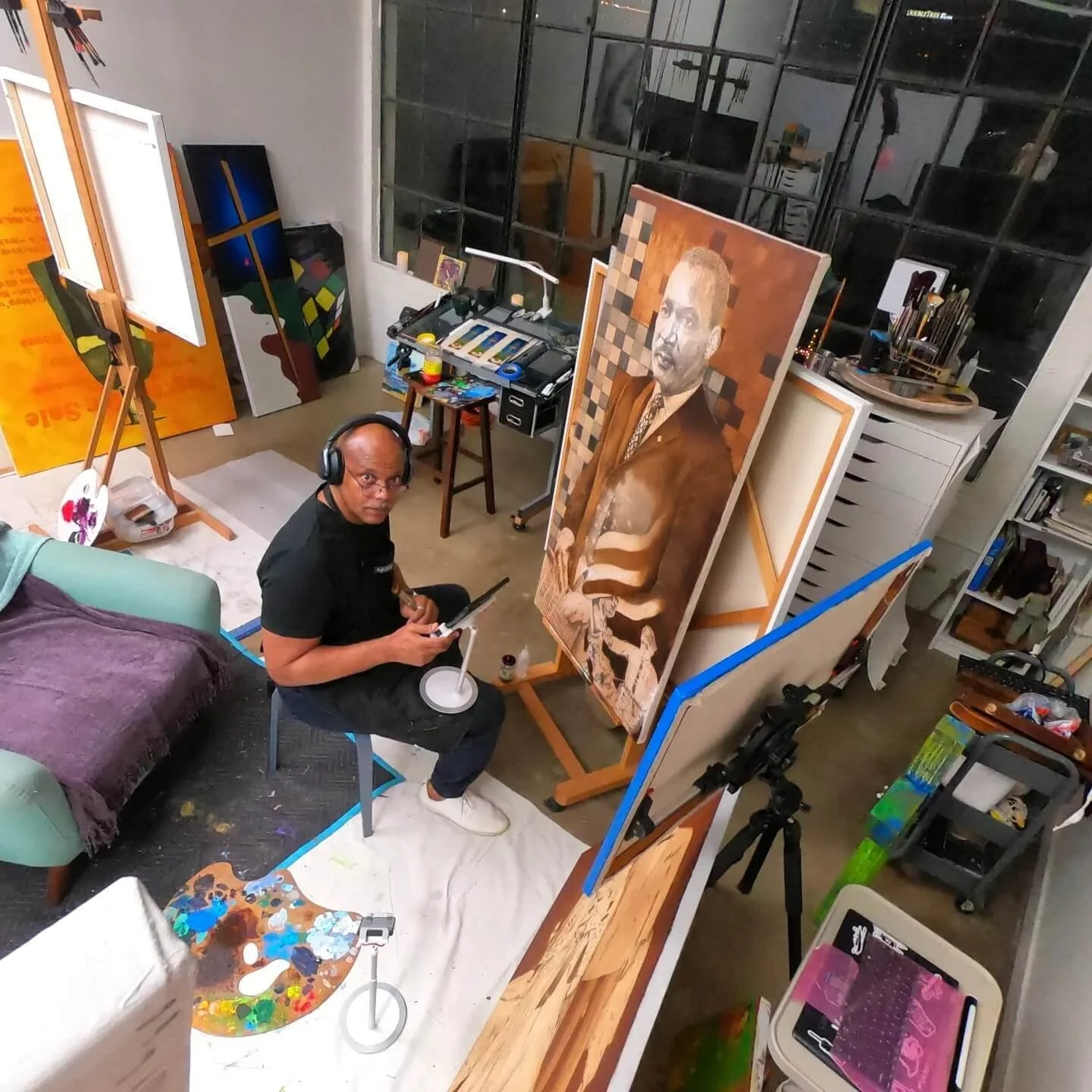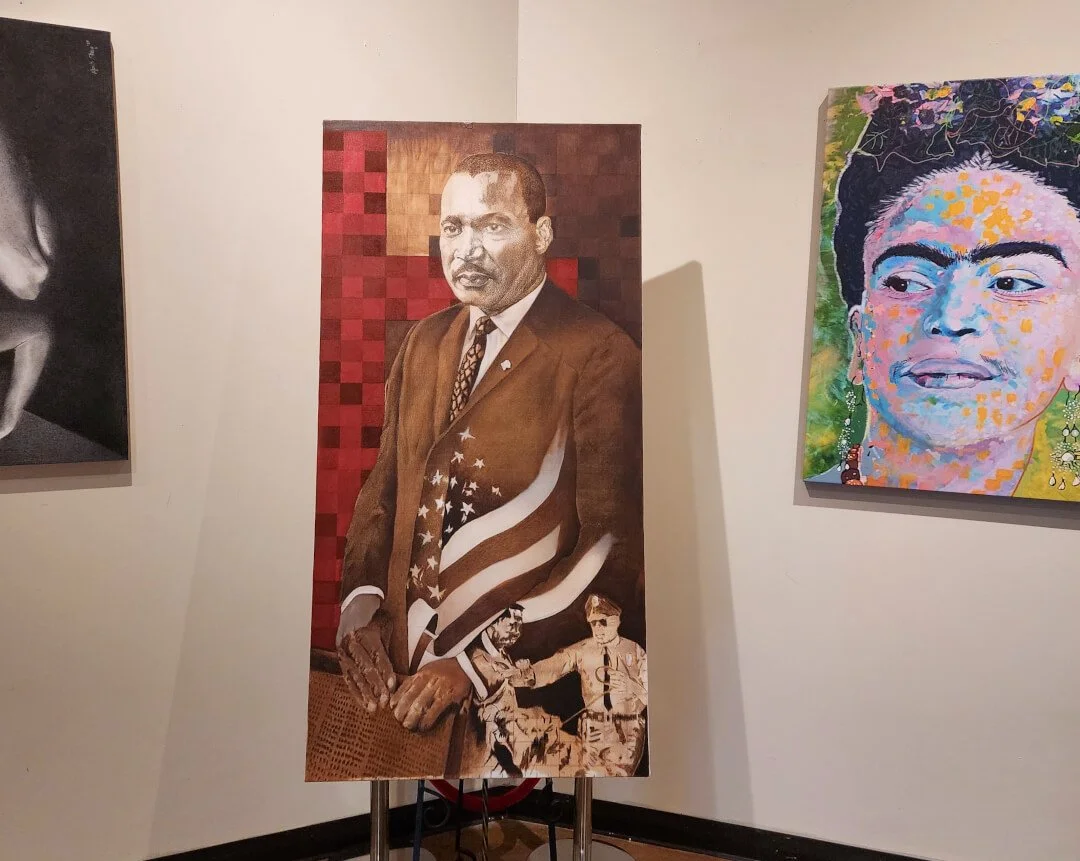PAINTING MARTIN LUTHER KING, JR.
Six months. That’s how long I had to turn a dream—my first solo museum show—into reality.
It was summer 2023 when I got the call, and the show was set for Black History Month the following February 2024. I was thrilled—but that excitement quickly turned anxious. February sounds far off until you realize how much work needs to get done in that short window. If I worked every waking moment—day and night, no breaks, no distractions—I might just have enough pieces for a respectable showing.
That’s when my curator—also my sister, my toughest critic—dropped the bombshell: “We need a showstopper.”
My first reaction was, “Aren’t they all showstoppers?”
Just kidding. I knew what she meant. This show wasn’t just a milestone for me—it was Black History Month. I needed to rise to the occasion. But would I be able to do it?
And yeah, maybe it’s a little on the nose—but I realized the right thing to do was bring the Rev. Dr. Martin Luther King Jr. into the room.
This wasn’t just any show. This was for Black History Month—a celebration of resilience, vision, and unfinished revolutions. How could I not paint Dr. King?
But how do you capture the image, the legacy, the power of a man who was still becoming when he was taken?
I had no idea if I even had time to pull anything more off, let alone a showstopper. Maybe the answer wasn’t to dwell on finishing him—but just to let him speak, unfinished if necessary, to those who need him.
What was clear was that I didn’t have time to stand there asking myself that question. I decided to go for it. I had to get to work, and that’s exactly what I did.
The process of creating a painting of Dr. King for my exhibition at the Northeast Louisiana Delta African-American Heritage Museum started the same way most of my paintings do—with a drawing.
I’ve been drawing my whole life, and mostly I’m attracted to murals or mural-style compositions. But I wanted to push past what I’d done before and come up with something new—something worthy of a museum exhibition for Black History Month.
I vacillated between doing something traditional and something more on the radical side. I felt uncertain about what the museum and its patrons would find “appropriate,” how much room I had to stretch between tradition and artistic license. Ultimately, since the clock was ticking, I had to put all that away and just go with what I do.
And so I came up with a composition that preserves his iconic posture but disrupts its serenity with a depiction of state-sanctioned violence—opposed in composition to a partially obscured, sacred symbol of sacrifice: the cross.
Monti Sharp in studio, working on “Dr. King” painting. © Sharp Art. All rights reserved.
It is part conservative, part radical. Somewhat like the man.
But let me share a little secret—just between you and me: this composition, indeed this entire painting, is incomplete as far as I’m concerned.
What you see here is simply the underpainting. I’m not even committed to the composition being final. But by the time I reached this point—mere days before the show—UPS was knocking.
Show it unfinished, or don’t show it at all?
It was quite a dilemma.
Selfishly, my first inclination was: “No way am I showing that.” But then I embraced the reality that the exhibition, although mine, wasn’t really about me. It was about Black History, of which I am a part. And by extension, this painting is a part—its subject, its creator, the viewers who would contemplate its form.
It is what it is.
And so, in a rare and uncharacteristic display of self-restraint, I put the brush down and began preparing the piece for shipment.
The first people to see it were in the Louisiana Living green room—Ashley Doughty, producer Scott Oglesby, and others waiting to applaud or judge.
It was a day before the show’s opening. My brilliant sister and I were next up on the show, and I had to unbox the piece so the crew could preset it for our segment after the next commercial break.
This was live television, and there was no time to second-guess anything.
Keep in mind, for the previous six months, I had been in my studio 24/7—painting and creating in preparation for the exhibition. I was painting until my Uber arrived. And now, under the studio lights, the director counted down: “3, 2, 1...”
In that moment, my head finally landed in Louisiana. I left Los Angeles behind and embraced the studio at KTVE-TV, an NBC affiliate in West Monroe.
It was my second time meeting Ashley, and I felt comfortable beside my Martin Luther King painting. As had others, Ashley expressed a deep appreciation for the work. She really seemed to like it. The show’s producer, Scott Oglesby, also loved it. So did many others who saw it that day.
I explained the painting’s meaning—really for the first time—and surprised myself at how conceptually complete it felt, even if the painting itself wasn’t.
I left that afternoon, the day before the exhibition, feeling proud and relieved. My curator/sister was pleased too. We had both done our jobs—with focus, with aplomb, and with excellence.
It was a photo finish—just like the six months of sleepless nights had demanded.
The painting showed at the museum for three weeks and was well received. I learned a lot from the experience.
I learned that a painting is complete when it comes into the presence of others, regardless of the state of its physical form. I learned that the conceptual part of a picture can often matter more than whether its composition follows the rule of thirds or whether it’s technically precise.
People have hearts and minds.
And in the final analysis, what matters is how their perception—their life experience—completes the picture. How it gives them what they need to take away from it.
In a way, it made perfect sense.
Painting of Dr. Martin Luther King, Jr. by Monti Sharp on display at the Northeast Louisiana Delta African-American Heritage Museum. 2024.
Martin Luther King Jr., like my painting, was perhaps an unfinished work. A treasure thrust into the midst of a waiting audience, so they could feed on it and take something meaningful with them into the rest of their lives.
I like to think my painting of the man was something like that too.
Regardless of how I feel about it—or what I think about it—it was a complete work.
It is a complete work.
In all its incompleteness, it showed up.
Isn’t that what art—what history—demands of us? -


